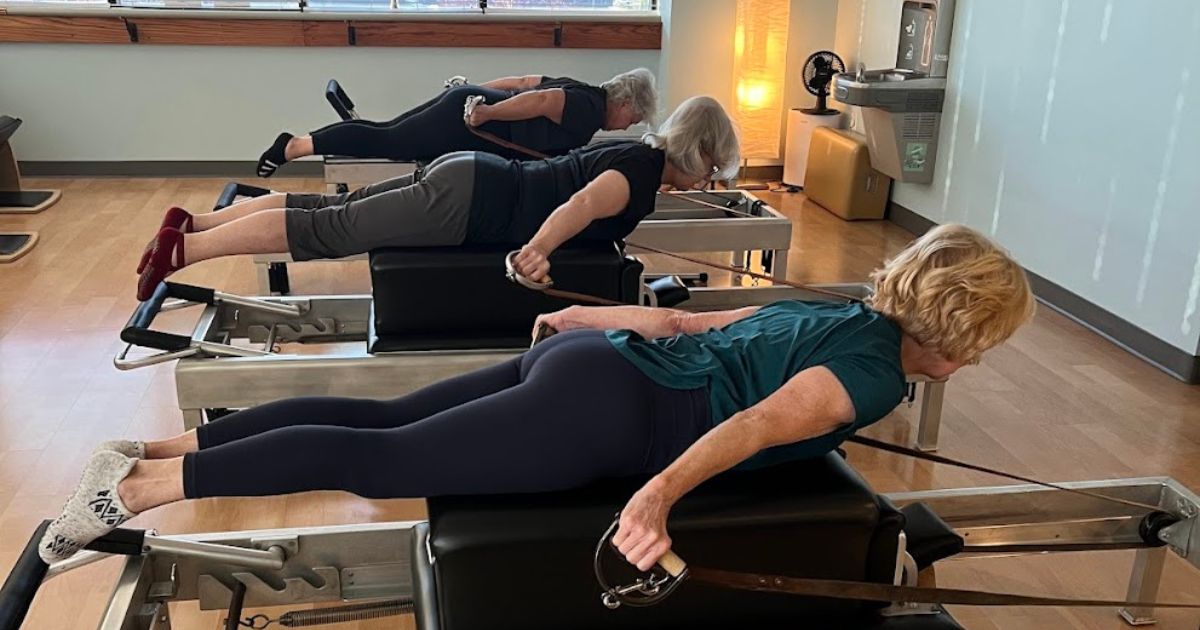If you’ve been practicing Pilates for a while, you may have heard about the importance of creating resistance within the body to achieve a deeper stretch. This is an important concept in Pilates and is the key to unlocking deeper strength, stretch, and control in your movements. It’s also referred to as a two-way stretch, oppositional reaching, or finding internal resistance. This is not an isometric hold, but what does it really mean, and why is it so important?
Understanding Resistance in the Body
Creating resistance in the body means simultaneously reaching in opposite directions, engaging muscles to lengthen and strengthen at the same time. Imagine stretching a rubber band: As you pull both ends apart, tension increases, but so does elasticity. This same principle applies in Pilates. When you’re working in two directions, the muscles lengthen and strengthen in their elongated form (an eccentric contraction, we’ll save that for another blog).
Rather than just performing an exercise by moving from point A to point B, actively engaging resistance encourages you to activate your muscles in a way that creates dynamic length and stability. It’s the secret sauce that transforms Pilates from simply a workout into a powerful method of movement efficiency and control.
How It Works in Practice
Think about the roll-up on the mat. As you begin to lift your head and reach your arms forward, your lower body isn’t passive; your legs are energetically reaching in the opposite direction. This dual action keeps your core engaged and prevents you from simply muscling through the movement. Instead, you achieve a controlled, smooth articulation of the spine, making the exercise both more effective and safer.
Another classic example is the swan. As you lift your upper body into extension, you’re not just arching backward; your legs are actively reaching away, creating length through the entire front body while engaging the back body for support. This resistance prevents compression in the lower back and enhances the full-body benefits of the exercise: to free the spine and open the chest!
The Benefits of Creating Resistance
Engaging resistance within the body offers several benefits beyond just making the exercises look graceful. Here’s what it can do for you:
- Improves Strength and Length – By reaching in opposite directions, you simultaneously strengthen and lengthen muscles, creating balanced muscle development. Otherwise, there are certain muscles that will dominate and why would want to keep enforcing bad habits?
- Enhances Core Engagement – The deep engagement required keeps the core activated throughout your movement, leading to greater stability and control. Having a strong center and moving from a place of strength is more powerful than working from your appendages.
- Prevents Overuse of Superficial Muscles – Rather than gripping or tensing, creating resistance ensures a deeper, more connected activation of muscles, reducing strain. Pilates is all about using your muscles in a balanced manner. It’s like hitting the tennis ball in the “sweet spot” of the racquet. Just enough muscle but not too much!
- Promotes Fluidity and Ease – Movements become more effortless and controlled, aligning with the Pilates principle of efficiency. Make it look easy on the outside but feeling it deeply on the inside is what we’re after here!
- Increases Body Awareness – It deepens your connection to how your body moves, allowing for greater precision and refinement. As I always say, this is one of the best gifts Pilates has given me. Learning how to hold myself together and move has been a game changer for me. I’m still learning, but I know this will only help me as I get older.
Applying Resistance in Your Pilates Practice
To integrate this concept into your practice, start by approaching each exercise with a sense of internal resistance. Here are a few tips:
- Focus on Length, Not Just Movement – In every exercise, ask yourself, “Where am I reaching from? Where am I reaching for?”
- Engage From Your Center – Think of your core as the anchor from which energy radiates outward in two directions.
- Use Your Breath – Inhale to prepare and exhale to deepen into the stretch, feeling the resistance grow stronger.
- Stay Present – Avoid rushing through movements; instead, focus on the quality and connection of each reach. Take your time and make your body work for you.
The Never-Ending Journey
Like everything in Pilates, the practice of creating resistance is not something you “achieve” once and then forget about or move on from. It’s an important concept that continues to evolve in your practice. As Joseph Pilates said, “Pilates is complete coordination of body, mind, and spirit.” When you find internal resistance, you tap into this harmony, experiencing Pilates in its fullest expression.
So next time you step onto the mat or the apparatus, don’t just go through the motions. Create resistance, feel your body lengthen, and watch how it transforms your movement, your strength, and your connection to your body.

